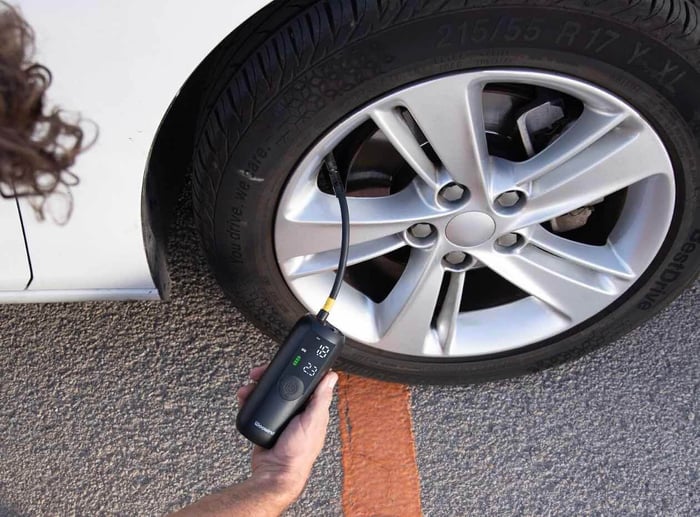
Why Tire Pressure Matters — And How to Put Air in Car Tires
Knowing how to put air in car tires is a simple skill that makes a big difference in your safety, fuel efficiency, and ride comfort. It’s one of the easiest ways to care for your car—and yet, many drivers either guess or delay doing it until a warning light flashes.
I used to be one of those drivers. But once I learned to check my PSI and inflate properly using a smart inflator, everything changed: smoother rides, better gas mileage, and no more last-minute gas station stops.
Whether you're preparing for a road trip or just want to drive confidently every day, learning this process—especially with a reliable tool like the Woowind LP1 smart inflator—can save time and stress.
Table of Contents
Before You Begin: Know Your Recommended Tire PSI
Every vehicle has a specific PSI (pounds per square inch) level for ideal tire pressure. You’ll find it on a sticker inside the driver-side door jamb or in your owner’s manual. Always check your tire pressure when the tires are cold for the most accurate reading—first thing in the morning or after the car has been parked for a few hours.
If you're not sure what PSI your tires need or why it matters, this guide on how much PSI your car tires should have explains it clearly with helpful examples.
Tip: Don’t forget the spare! Most of us overlook it until it’s too late.
Portable vs. Gas Station Pumps: Why I Use the Woowind LP1
There are plenty of ways to inflate tires, but not all of them are convenient or accurate. Gas station air pumps are often broken, coin-operated, or hard to use. That’s why I switched to the Woowind LP1, a compact, USB-C rechargeable smart inflator that fits easily in my glovebox.
The LP1 features four inflation modes, a flexible air hose, and an LED light—all packaged in a sleek, portable design. And unlike most manual pumps, it includes an auto shut-off function that ends inflation exactly at your target PSI.
If you want to compare other inflators in Woowind’s lineup, check out their full collection of car air pumps here.
Step-by-Step: How to Put Air in Car Tires With the Woowind LP1
Here’s exactly how I use the Woowind LP1 to fill my tires at home or on the go:
Charge the Device
Use the included USB-C cable to fully charge the LP1 before use (about 2–3 hours).
A full charge inflates up to 8 car tires—plenty for a week or a road trip.
Choose the Mode
Press the mode button to toggle between Car, Motorcycle, Bike, and Ball modes.
The Car mode sets a PSI baseline—you can adjust it to match your specific need using the “+” and “–” buttons.
Attach the Hose
Remove your tire's valve cap.
Connect the LP1’s flexible threaded hose securely to the Schrader valve.
A snug fit prevents air leaks.
Inflate Automatically
Press the power button to start.
The LP1 inflates quickly and automatically stops once your set PSI is reached.
No manual monitoring. No guesswork.
Confirm and Store
Detach the hose, replace the valve cap, and check the final pressure on the LP1’s screen.
Store the inflator and recharge as needed.
For more options, visit Woowind’s complete electric air pump guide.

Avoid These Mistakes: Overinflation, Valve Issues & Power Tips
Here are a few common errors I’ve learned to avoid—and how the LP1 helps fix them:
Overinflation: With auto shut-off, LP1 ends inflation precisely at the target PSI.
Valve leaks: Always clean the valve stem before connecting the hose to ensure airtight inflation.
Running out of power: Recharge the LP1 regularly. Keep a USB-C cable in your vehicle just in case.
Wrong preset mode: Double-check you're in Car mode, then adjust PSI manually for your specific model.
If you're preparing for longer journeys, here's a helpful resource on managing tire pressure during long-distance travel.
Tire Maintenance Routine: Monthly Checks and Spare Tire Tips
Good tire care doesn’t stop after a single fill-up. Here's my go-to routine for keeping all five tires (yes, including the spare) in great shape:
Check all four tires and the spare once a month
Keep the LP1 charged and stored in the trunk
Use the digital screen to get quick, precise PSI readings
Adjust PSI based on season—cold weather drops tire pressure
FAQs
How often should I check my tire pressure?
You should check your tire pressure at least once a month and before any long trips. Tire pressure can fluctuate with temperature changes, especially in cold or hot weather. Regular checks help improve fuel efficiency, handling, and safety.
What PSI should I inflate my car tires to?
The ideal PSI for your tires is usually listed on a sticker inside the driver-side door or in your vehicle’s manual. For most passenger cars, it falls between 32 and 35 PSI when the tires are cold. Always check when the tires haven’t been driven recently for the most accurate reading.
Can I use the Woowind LP1 for other things besides car tires?
Yes, the Woowind LP1 is designed to be versatile. It includes multiple inflation modes and adapters, making it suitable for bicycles, motorcycles, and sports balls. Its compact size makes it a convenient all-in-one solution for everyday and travel use.
Do I need to keep the car engine running when using the LP1?
No, the LP1 runs on a built-in rechargeable battery, so it doesn't need to be plugged into your car during use. Just make sure it’s fully charged before heading out. This makes it ideal for use even when the vehicle is turned off or when you're away from power sources.
Why is a smart inflator better than using a gas station air pump?
A smart inflator like the LP1 offers precise control, auto shut-off at your desired PSI, and the convenience of inflating your tires anytime, anywhere. Gas station pumps can be inaccurate, broken, or inconvenient—especially when you're in a hurry or it's late at night.
The LP1 takes the stress and guesswork out of tire care. Whether I’m commuting, heading out on a family trip, or just topping off before the weekend, I know I’ve got the right pressure every time.













